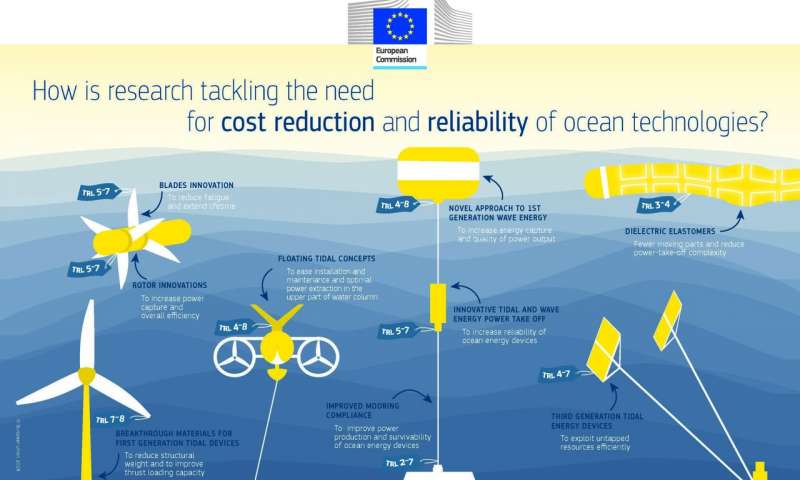
While the ocean energy sector is still at an early stage of development, a new report analyses ten future emerging technologies to generate energy from the ocean tides and waves.
An integrated systems approach is necessary for their successful commercialisation.
It still takes a level of almost science fiction fantasy to imagine that we can use the oceans’ permanent movement to power our cities and houses.
Yet, such ideas are on designer desks, going through demonstrations of viability, towards possible commercial success.
Moving to economically viable ocean energy technologies is a huge step towards decarbonisation and the growth of the blue economy in many coastal areas.
With only 17 MW compared to 15.8 GW of offshore wind of operating capacity installed in European waters, mostly as demonstration or first-of-a-kind precommercial projects, every technological solution proposed to bridge the gap between R&D stage and the commercialisation of ocean energy devices can be seen for the time being as a future emerging technology.
As part of the European Commission’s internal Low Carbon Energy Observatory (LCEO) project, the Joint Research Centre (JRC) is developing an inventory of Future Emerging Technologies relevant to energy supply.
30 experts in the ocean energy analysed the needs for the sector, and the type of innovations to bridge the gap with the market.
The new report, Future emerging technologies for the ocean energy sector: innovation and game-changers offers policy makers and all other ocean energy stakeholders an array of innovations that can bring ocean energy to the market, but it still needs further R&D, supported by private, national or European funding, and that would help maintain European leadership in this emerging sector.
The experts describe state of advancement of each of the technology family, advantages, technological limitations, as well as their technology readiness level.
Emerging industry brimming with ideas
In Europe a large variety of concepts have been developed for ocean energy conversion, with more than 200 different devices proposed.
The experts talk about ten ocean energy technology families, which group together wave or tidal converters, subsystems and components that are characterised by a common operating or design principle.
Tidal energy
In terms of speed of development, the first generation of tidal energy converters is heading the group.
They have reached the pre-commercial stage with the total installed capacity of around 12 MW in Europe and the speed of development is medium, with devices having reached maturity after 10+ years of R&D.
Floating tidal devices do not require heavy and costly foundation systems.
Speed of the technology development is medium/fast (meaning between less than 5 to 15 years), with some floating tidal platforms already at an advanced stage of development.
Third generation tidal energy converters extract energy from a tidal flow or water flow using the sails, kites, or simulating fish-swimming motion.
The speed of development is medium/fast, and is affected by the development of materials and ancillary technology.
Wave energy
As for wave energy, the research goes back 40 years.
The availability of testing facilities and new computational tools are making research more accessible and opening up new opportunities leading to novel approach to the first generation of wave energy concepts.
The advancement of artificial intelligence and learning algorithms offer an opportunity for developing designs which are more efficient.
Development speed is in medium-slow range.
Novel wave energy concepts exploit the material-flexibility and the orbital velocities of water particles to convert wave power to electricity.
They are characterised by an overall simplicity of design compared to first generation wave energy devices.
Yet they are at early stages of development, with no device installed in real sea and the maximum power rating for the device yet to be identified.
Innovative tidal and wave energy power take off
This big group of different approaches on how to extract power from the ocean and convert it into electricity offers many possibilities for innovation and unlocking the potential of ocean energy in Europe.
Direct drive, hydraulic and inertia systems are more advanced.
Mechanical systems can be at a relatively fast pace, while dielectric elastomers offer fast speed of development but require more R&D.
Further information on those concepts is available through Marinet 2 P Horizon 2020 project, the Wave Energy Scotland program and the European Marine Energy Centre list of wave and tidal energy technology.
Conclusions and recommendations for further work
An integrated systems approach is required to develop successful marine energy systems; therefore collaboration with industry and engagement with original equipment manufacturers from the early stage of development is recommended.
System capabilities and requirements should be properly defined and made transparent to increase the effectiveness of future emerging technologies development and applicability to ocean energy technologies.
The transferability of solutions from other sector, as well as the development of new technologies and materials could impact significantly on the speed of development of future emerging technologies for ocean energy.
The impact of the future emerging technologies should be put in the context of the priorities for the ocean energy sector as identified through the Ocean Energy Roadmap and the SET-Plan Implementation Plan.
A further analysis is needed to prioritise which options could have the greatest impact on the sector in achieving short-term goals (2025 targets) and long term ambitions (100 GW of installed capacity by 2050).
This report compiles the outcomes of an international workshop on emerging energy technologies held in March 2019.
